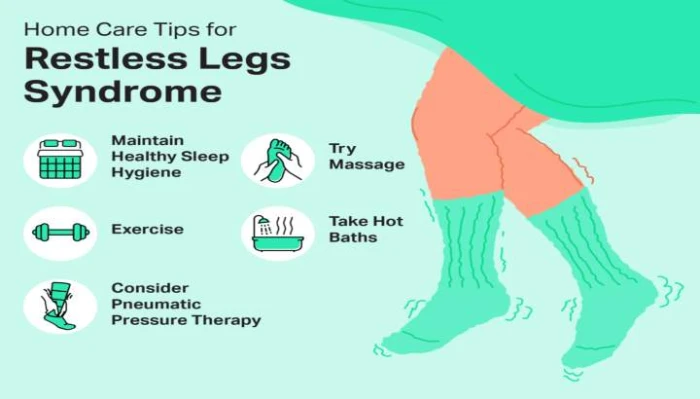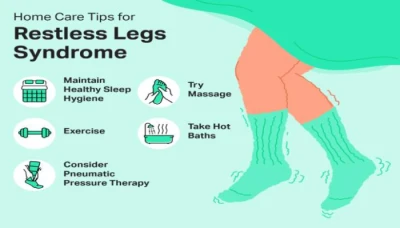How to Overcome the Restless Legs Syndrome?
People with Restless Legs Syndrome feel like they have to move their legs all the time.

Restless Legs Syndrome is when your legs feel weird, and you can't stop moving them. Something is crawling inside your legs, and you must move to stop it. It often occurs in the evening or night-time when someone sits or lies down. This syndrome can disrupt sleep, leading to daytime fatigue and a reduced quality of life.
Understanding the Restless Legs Syndrome
Causes and Risk Factors
Although the precise cause of RLS is unknown, several conditions are thought to be associated with it.
- Genetics
RLS can run in families, indicating a genetic component.
- Iron Deficiency
Low iron levels in the brain can trigger RLS symptoms.
- Chronic Diseases
Conditions like Parkinson's, diabetes, and kidney failure are associated with RLS.
- Medications
Some medications, such as antipsychotics, ant nausea medications, some antidepressants, and medications for cold and allergy symptoms, can exacerbate symptoms.
- Pregnancy
Pregnancy, especially in the last trimester, can trigger RLS. Usually, the symptoms go away a month following delivery.
Symptoms
The primary symptom of RLS is an uncontrollable urge to move the legs. This sensation is often accompanied by the following.
- Tingling, burning, or itching in the legs.
- Symptoms that worsen at night.
- Relief with movement.
- Difficulty sleeping due to leg discomfort.
Diagnosis
Diagnosing RLS is primarily based on a patient's description of symptoms. Physicians may use the following criteria.
- Strong urges to move the legs, often accompanied by uncomfortable sensations.
- The problem starts or worsens when you're resting or not doing much.
- Moving around helps to make the problem feel better, but only partially.
- The problem is usually more vital at night.
Treatment and Management
1. Lifestyle Changes
- Exercise Can Help With Restless Legs
If you exercise regularly, it might help your legs feel better. But if you do too much, it could make them feel worse.
- Sleep is Essential
Going to bed and waking up at the same time daily can help you sleep better. Make sure your bedroom is dark, quiet, and relaxed.
- Some Things Can Worsen Restless Legs
Drinking coffee, alcohol, or smoking might make your legs feel bad. Try to drink and smoke less.
2. Nutritional Supplements
- Iron Supplementation
Supplements can be beneficial if tests show low iron levels.
- Magnesium and Folate
These supplements may also help some individuals.
3. Medications
- Anticonvulsant Medicines
Drugs like gabapentin can help calm things down.
- Dopamine Medicines
These help boost brain power and often work well. Pramipexole and ropinirole are examples.
- Benzodiazepines
These can help you sleep, but they're not suitable for long-term use because they can be habit-forming.
- Opioids
In terrible cases, doctors might give you a small amount of strong pain medicine.
4. Medical Devices
- Devices such as pneumatic compression devices or vibrating pads can provide symptom relief.
Understanding the symptoms, available treatments, and effective management strategies is crucial for individuals suffering from RLS.
Symptoms of Restless Leg Syndrome in Detail
People with Restless Legs Syndrome feel like they have to move their legs all the time. Their legs feel funny like they are tingling, burning, or itching. These feelings are worse when they are still, especially at night. Because of this, they can't sleep well and feel tired and grumpy during the day. Some people have mild RLS, but for others, it's awful and bothersome.
Restless Legs at Night
RLS is worse at night, making it hard to fall asleep or stay asleep. This insufficient sleep makes you tired during the day, and then RLS worsens. So, fixing the night-time problem is essential to help RLS and help them sleep better.
Instant Relief From RLS (Restless Leg Syndrome)
There are easy things you can do to feel better when your legs feel restless. Stretching your legs can help a lot. Massaging your legs, taking a warm bath, or using something hot or cold on your legs can also help. Moving your body during the day can help too, but don't do hard exercise right before bed because it might make your legs feel worse.
Therapies to Overcome Restless Legs Syndrome
Various therapies can help manage RLS symptoms and improve quality of life. Pharmacological treatments often include medications such as dopamine agonists, anticonvulsants, and Opioids, prescribed based on the severity of the condition. Additionally, non-pharmacological therapies like pneumatic compression devices, which improve blood flow, and transcutaneous electrical nerve stimulation (TENS), which provides electrical impulses to nerves, can be beneficial.
Nervous Leg Syndrome and Irritable Leg Syndrome
RLS is sometimes called Nervous Leg Syndrome or Irritable Leg Syndrome, reflecting the agitation and restlessness experienced by sufferers. Despite the different names, the underlying symptoms and treatment approaches remain consistent. Understanding these terms can help individuals recognize and seek appropriate treatment for their condition.
Treatment for Restless Leg Syndrome
Try taking medication and altering your lifestyle to help with restless legs. Going to bed and waking up at the same time everyday, drinking less coffee and alcohol, and stopping smoking can help. If you don't have enough iron, taking iron pills might work because low iron can cause restless legs. For terrible cases, there are notable medicines that a doctor can prescribe.
RLS is a problem, but you can handle it. It can make your life challenging, but if you change how you live and take medicine, you can feel much better. Knowing about RLS early is essential so you don't get worse problems like not being able to sleep. Scientists are still learning about RLS and will find better ways to help people in the future.
It is a really annoying problem that makes it hard to sleep and feel good. It's important to know what it feels like and what can be done to help. There's no magic cure, but there are things you can do to feel better. If you think you might have it, talk to a doctor. With the right help, you can feel better and sleep better too.
Also, give a quick read to the following related posts.

Restless Legs Syndrome is when your legs feel weird, and you can't stop moving them. Something is crawling inside your legs, and you must move to stop it. It often occurs in the evening or night-time when someone sits or lies down. This syndrome can disrupt sleep, leading to daytime fatigue and a reduced quality of life.
Understanding the Restless Legs Syndrome
Causes and Risk Factors
Although the precise cause of RLS is unknown, several conditions are thought to be associated with it.
- Genetics
RLS can run in families, indicating a genetic component.
- Iron Deficiency
Low iron levels in the brain can trigger RLS symptoms.
- Chronic Diseases
Conditions like Parkinson's, diabetes, and kidney failure are associated with RLS.
- Medications
Some medications, such as antipsychotics, ant nausea medications, some antidepressants, and medications for cold and allergy symptoms, can exacerbate symptoms.
- Pregnancy
Pregnancy, especially in the last trimester, can trigger RLS. Usually, the symptoms go away a month following delivery.
Symptoms
The primary symptom of RLS is an uncontrollable urge to move the legs. This sensation is often accompanied by the following.
- Tingling, burning, or itching in the legs.
- Symptoms that worsen at night.
- Relief with movement.
- Difficulty sleeping due to leg discomfort.
Diagnosis
Diagnosing RLS is primarily based on a patient's description of symptoms. Physicians may use the following criteria.
- Strong urges to move the legs, often accompanied by uncomfortable sensations.
- The problem starts or worsens when you're resting or not doing much.
- Moving around helps to make the problem feel better, but only partially.
- The problem is usually more vital at night.
Treatment and Management
1. Lifestyle Changes
- Exercise Can Help With Restless Legs
If you exercise regularly, it might help your legs feel better. But if you do too much, it could make them feel worse.
- Sleep is Essential
Going to bed and waking up at the same time daily can help you sleep better. Make sure your bedroom is dark, quiet, and relaxed.
- Some Things Can Worsen Restless Legs
Drinking coffee, alcohol, or smoking might make your legs feel bad. Try to drink and smoke less.
2. Nutritional Supplements
- Iron Supplementation
Supplements can be beneficial if tests show low iron levels.
- Magnesium and Folate
These supplements may also help some individuals.
3. Medications
- Anticonvulsant Medicines
Drugs like gabapentin can help calm things down.
- Dopamine Medicines
These help boost brain power and often work well. Pramipexole and ropinirole are examples.
- Benzodiazepines
These can help you sleep, but they're not suitable for long-term use because they can be habit-forming.
- Opioids
In terrible cases, doctors might give you a small amount of strong pain medicine.
4. Medical Devices
- Devices such as pneumatic compression devices or vibrating pads can provide symptom relief.
Understanding the symptoms, available treatments, and effective management strategies is crucial for individuals suffering from RLS.
Symptoms of Restless Leg Syndrome in Detail
People with Restless Legs Syndrome feel like they have to move their legs all the time. Their legs feel funny like they are tingling, burning, or itching. These feelings are worse when they are still, especially at night. Because of this, they can't sleep well and feel tired and grumpy during the day. Some people have mild RLS, but for others, it's awful and bothersome.
Restless Legs at Night
RLS is worse at night, making it hard to fall asleep or stay asleep. This insufficient sleep makes you tired during the day, and then RLS worsens. So, fixing the night-time problem is essential to help RLS and help them sleep better.
Instant Relief From RLS (Restless Leg Syndrome)
There are easy things you can do to feel better when your legs feel restless. Stretching your legs can help a lot. Massaging your legs, taking a warm bath, or using something hot or cold on your legs can also help. Moving your body during the day can help too, but don't do hard exercise right before bed because it might make your legs feel worse.
Therapies to Overcome Restless Legs Syndrome
Various therapies can help manage RLS symptoms and improve quality of life. Pharmacological treatments often include medications such as dopamine agonists, anticonvulsants, and Opioids, prescribed based on the severity of the condition. Additionally, non-pharmacological therapies like pneumatic compression devices, which improve blood flow, and transcutaneous electrical nerve stimulation (TENS), which provides electrical impulses to nerves, can be beneficial.
Nervous Leg Syndrome and Irritable Leg Syndrome
RLS is sometimes called Nervous Leg Syndrome or Irritable Leg Syndrome, reflecting the agitation and restlessness experienced by sufferers. Despite the different names, the underlying symptoms and treatment approaches remain consistent. Understanding these terms can help individuals recognize and seek appropriate treatment for their condition.
Treatment for Restless Leg Syndrome
Try taking medication and altering your lifestyle to help with restless legs. Going to bed and waking up at the same time everyday, drinking less coffee and alcohol, and stopping smoking can help. If you don't have enough iron, taking iron pills might work because low iron can cause restless legs. For terrible cases, there are notable medicines that a doctor can prescribe.
RLS is a problem, but you can handle it. It can make your life challenging, but if you change how you live and take medicine, you can feel much better. Knowing about RLS early is essential so you don't get worse problems like not being able to sleep. Scientists are still learning about RLS and will find better ways to help people in the future.
It is a really annoying problem that makes it hard to sleep and feel good. It's important to know what it feels like and what can be done to help. There's no magic cure, but there are things you can do to feel better. If you think you might have it, talk to a doctor. With the right help, you can feel better and sleep better too.
Also, give a quick read to the following related posts.
Conversation
Latest Blogs
© Blog CoolCalculator, Explore CoolCalculator, your destination for the latest insights, tips, and updates on the world of online calculators. Stay informed and make your calculations smarter with our blog. ,
Designed
by Saad Media Team , Team Lead M.Rizwan Akhtar












